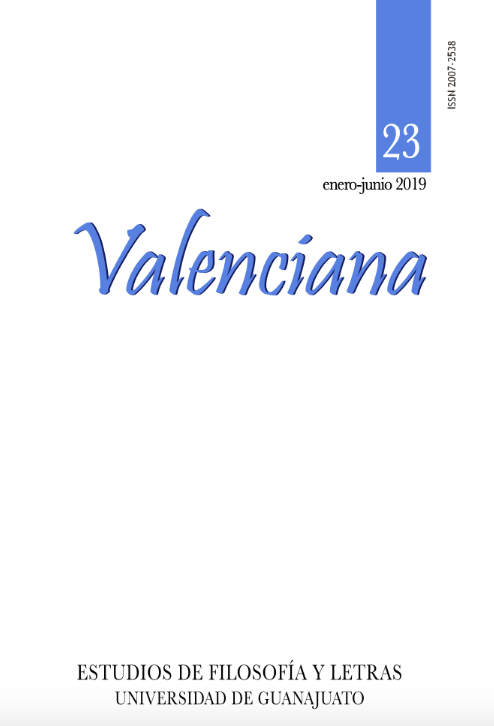“Episodio en la huerta...”, by Agustín Yáñez. Couting rhymes with “El milano”, citing the fighting bull
DOI:
https://doi.org/10.15174/rv.v0i23.406Abstract
In “Episodio en la huerta...”, Jacinto after one and half month of convalescence, watched his neighbors playing the round “El Milano” and remembers how his cousins played it too. Over all, he remembers the hallucinations that fever has produced to him. In these, certain images of the round are superimposed –the bull, the kite, the rose, the carnation– with others images from the movie La alondra y el Milano. Through these associations, the child tries to reveal the erotic meaning of the round. In such way, the round is not incorporated into his speech to become a song or a game, and it is what the rounds are cited for; the fragments that are repeated are rather images or symbols that become an instrument to become aware of their desire and, at the same time, of his lost childhood. Following the narratological theory of Graciela Reyes’s research on citation, in this paper, I support this thesis: not the game, in the actantial plane, but the citation of certain words or phrases, in the discursive plane, allow the child to find the meaning of his hallucinations and finally, access to the revelation of the mystery, the awakening of the sexual drive.References
Barthes, Roland, 1980, S/Z, traducción de Nicolás Rosa, Siglo XXI, México, 221 p.
Blancas, Noé, 2018, “ ‘Episodio de las hebritas de oro’. Hilos entre el romance y el relato”, Hipogrifo, núm. 6.1., España, mayo 2018, pp. 503-522.
Borges, Jorge Luis, 1956, “Pierre Menard, autor del Quijote”, Ficciones, Emecé, Buenos Aires.
Carballo, Emmanuel, 1994, Protagonistas de la literatura mexicana, México, Porrúa.
Cerrillo, Pedro C., 2009, “Las oraciones de tradición infantil”, Revista de literaturas populares, núm. 1, año IX, enero-junio, pp. 137-163.
Corominas, Joan, 1976, Breve Diccionario etimológico de la lengua castellana, 3ª ed., Gredos, Madrid, 627 p.
DRAE. Diccionario de la Real Academia de la Lengua Española.
Freud, Sigmund, 1992, Obras completas VII. Fragmento de análisis de un caso de histeria (Dora). Tres ensayos de teoría sexual y otras obras (1901-1905), Amorrortu editores, Buenos Aires, 314 p.
Frenk, Margit, 2013, “Rimas para juegos infantiles en el antiguo cancionero popular”, Ocnos, 9, pp. 7-20. Recuperado de: http://www.revista.uclm.es/index.php/ocnos/issue/view/125
Frenk, Margit, 2003, Nuevo Corpus de la antigua lírica popular hispánica (siglos XV a XVII), UNAM/Colegio de México/FCE, México, 2 Tomos
García Meza, 2001, Al filo del agua. Voces y memoria, Universidad Juárez Autónoma de Tabasco, Villahermosa.
Marquet, Antonio, 1997, Archipiélago dorado. El despegue de la obra narrativa de Agustín Yáñez, UAM-Azcapotzalco, México.
Malvido, Elsa, 2008, “La muerte en la lírica infantil colonial mexicana”, Revista Cultura y Religión, Núm. 1, Vol. 2, junio. Recuperado de: https://www.researchgate.net/publication/26553246_La_Muerte_en_la_Lirica_Infantil_Colonial_Mexicana
Marina, J.A. y López, Marisa, 1999, Diccionario de los sentimientos, Barcelona, Anagrama.
Martínez, José Luis, 1991, La obra de Agustín Yáñez, Universidad de Guadalajara, Guadalajara,
Moliner, María, 1998, Diccionario de uso del español, Gredos, Madrid, 2ª ed., 2 vols.
Pelegrín, Ana, 2002, Juegos y poesía popular en la literatura infantil-juvenil, 1750-1987. Tesis doctoral, Madrid, Universidad Complutense de Madrid, 417 p.
Rangel Guerra, Alfonso, 1998, “Prólogo”, en Yáñez, Agustín, Obras I, Colmex, México, pp. 5-111.
Yáñez, Agustín, 1967, Flor de juegos antiguos, Organización Editorial Novaro, México, 157 p. [1ª ed., 1941].
Young, Richard A., 1978, Agustín Yáñez y sus cuentos, Tamesis Books, London. 156 p.
Published
How to Cite
Issue
Section
License
Author(s) who publish in this journal do accept the next conditions:
According to copyright regulations, Valenciana does recognize and respect the authors’ moral right, as well as the right of property, which will be assigned to the journal for its diffusion in open access.
Valenciana does not charge authors for the submission, editorial process or publication in the journal.
All texts published and distributed by Valenciana (without exception) are supported by the license Creative Commons Attribution-NonCommercial 4.0 International (CC BY-NC 4.0), which allows third parties to use the publication as long as they mention the author and the first publication.
Authors can make other independent and additional contractual agreements for the non-exclusive use of his article published in Valenciana (e.g. including it in an institutional repository or in printed/electronic media), as long as it is explicitly clarified that the article was published for the first time in this journal.
For these purposes, authors must sign and send the letter of submission and copyright transfer form in a PDF file to this email address: revistavalenciana@gmail.com
This journal is under a license by Creative Commons Atribución-NoComercial-SinDerivadas 4.0 Internacional (CC BY-NC-ND 4.0)).











